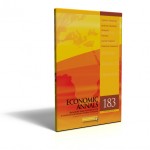INFORMATION TECHNOLOGY DEPLOYMENT IN A TRANSITION ECONOMY: RESULTS FROM SLOVENIA
##plugins.themes.bootstrap3.article.main##
##plugins.themes.bootstrap3.article.sidebar##
Tomaž Hovelja
Abstract
Information technology (IT) is increasingly establishing itself as one of the major topics of study in the OECD area. The resulting OECD studies found that IT has an enormous productive potential; however before an economy can gain most of IT’s benefits, several challenges need to be successfully addressed. The key challenges these studies identified are adequate organisational transformations of the enterprises and adequate reorganisation of key national institutions. How these two challenges are tackled by the economies that are going through the transition from a socialist towards a coordinated/liberal market economy is, unfortunately, not equally well documented. To improve this situation in this paper I present new findings from one transition economy concerning the issues that the developed OECD countries already highlighted as critical for the successful deployment of IT, and issues that seem specific to the transition environments. The presented findings are based on the study I conducted into 94 enterprises, representing the population of the 914 biggest added value generating enterprises in Slovenia. This article thus tries to allow Slovenia and other economies in a similar situation to draw broad and important conclusions with managerial and political implications on how to deploy all available IT potential.
##plugins.themes.bootstrap3.article.details##
Keywords
Information technology deployment, organisational transformation, enterprises, institutions, Slovenia
JEL Classification
M10, O14
Issue
Section
Articles
How to Cite
Hovelja, T. (2009). INFORMATION TECHNOLOGY DEPLOYMENT IN A TRANSITION ECONOMY: RESULTS FROM SLOVENIA. Economic Annals, 54(183), 56-88. https://doi.org/10.2298/EKA0983056H
How to Cite
Hovelja, T. (2009). INFORMATION TECHNOLOGY DEPLOYMENT IN A TRANSITION ECONOMY: RESULTS FROM SLOVENIA. Economic Annals, 54(183), 56-88. https://doi.org/10.2298/EKA0983056H

